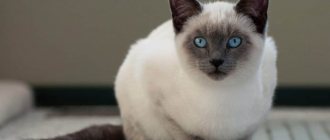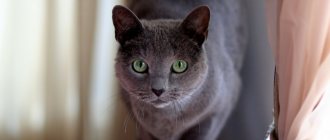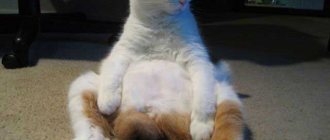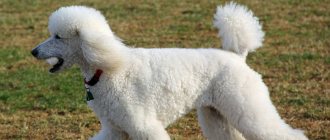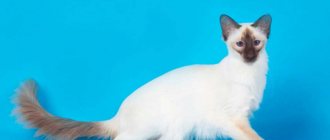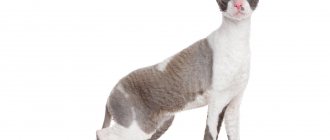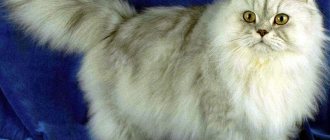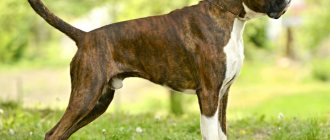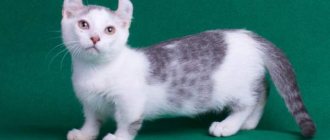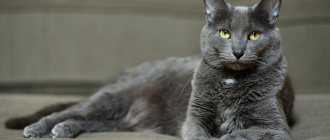According to legend, the cat was the last animal to be domesticated by man. Self-sufficient and independent, capricious and jealous, arrogant and affectionate - all this can be said about purring pets. Despite their freedom-loving disposition, they are able to become touchingly and deeply attached to their owner, sharing their mood and leisure time.
Different breeds of cats differ in temperament, requirements for grooming and maintenance, and even in their ability to build relationships with people and other animals. These nuances must be taken into account when choosing a furry friend.
Famous, popular breeds of short-haired cats: photos, description of character
Many people prefer to have a short-haired cat because it is easier to care for. In addition, short pile does not hide the beauty of the animal’s body. Let us describe some of the most striking and interesting breeds.
The Brazilian Shorthair is an aristocratic natural breed. Outwardly it looks like a courtyard. It has a small muscular body, a wedge-shaped head and almond-shaped eyes.
In cats of this breed, the character develops throughout life and depends on how the owners treat it:
- kind by nature, from lack of attention and affection these pussies can become nervous and irritable
- sociable and playful
- wonderful hunters
- love walks
- require love and attention
- easy to train and easy to train
Brazilian Shorthair
The American Shorthair is a powerful, strong animal with a rounded head and well-developed chest. May have different colors.
Is different:
- endurance
- good health
- love for jumping
- courage
- intelligence
- tenderness and affection towards the owner
- laziness, so it is necessary to force her to move actively
- are greedy when it comes to food
- independent but obedient
American Shorthair
The Siamese cat is a bright short-haired cat that cannot be confused with other breeds due to its unique color, thin body structure and blue eyes. It is noteworthy that this breed was not crossed with anyone.
They have a rather unique character:
- stubborn and willful
- independent
- have strong hunting instincts
- very attached to the owner and very jealous of him
- wary and distrustful of strangers
- sensitive to the owner's mood
- playful, love attention
- in case of disagreement, they “swear” loudly
Siamese cat
The Thai cat is an oriental breed that can have different colors, except pure white. It has a muscular, graceful body, a slightly wedge-shaped head and blue eyes.
Main features:
- observant and curious
- very smart, quickly learns to open closed doors
- extremely devoted to the owner: she rejoices at the arrival, and during his illness does not leave him
- tries to take a leading position among other pets
- quite talkative
Thai cat
The European Shorthair (Celtic cat) is a fairly massive animal that has unique hunting qualities. There are a lot of color variations. The character is purely individual and largely depends on the upbringing and attitude of the owner towards the animal. For the most part these animals:
- smart
- affectionate
- attached to their owner
- easy to adapt
- easy to care for
- have an independent character
European Shorthair
Australian aya mist (Australian smoky). One of the unique new breeds. Almost never found outside of Australia. It has a spotted or marbled spotted color and beautiful aquamarine eyes.
Cat of this breed:
- has an easy-going disposition
- sociable and friendly
- not afraid of strangers
- loves children
- playful and active
- easily tolerates loneliness
- calmly relates to closed spaces and lack of walks
Australian mist
The German (Prussian) Rex is a cross between the Angora and Russian Blue. Owners of wavy plush fur.
The nature:
- calm, even lazy
- patient and enduring
- It is believed that they can take on the traits of their owner
- require a lot of love and affection
German Rex
The Bengal cat is a medium-sized artificially bred breed with a spotted color like a leopard.
Such animals:
- very active, even mischievous
- love walking, allowing you to put on a leash
- have high intelligence
- love to fight and hunt
- can make a variety of sounds
- quite kind and friendly
Bengal cat
The Manx cat is a large, strong, muscular cat. The tail is very short, similar to a hare's.
They differ in the following features:
- very active and playful
- sociable, take an active part in everything
- emotional
- loving and spontaneous
- are partial to water, but do not like to swim
- wonderful fast hunters
Manx tailless cat
The used cat is a medium-sized animal. She is the owner of a proportionate body, well-developed muscles, round amber eyes and unusually silky fur.
It has a wonderful light character:
- extremely sociable
- very loyal to a person
- smart and understanding
- loves physical contact
- devoid of aggressiveness
- requires attention
- loves active games
The Pixie Bob is a young breed created by crossing domestic cats and wild short-tailed cats. It has a muscular body and a short straight tail. Externally they look like a lynx.
Despite the appearance of a wild animal, they have an easy-going character:
- kind and gentle
- quickly become attached to the family and owner
- very active, love to jump and play
Pixiebob
Oriental is an elegant oriental cat of various colors, except white. Has large ears and expressive eyes. Has the same standard as the Siamese cat. Just as graceful and elegant.
Peculiarities:
- has a shrill voice
- very trusting
- inquisitive
- sociable
- not afraid
- is in constant motion
- trains well
- can walk on a leash and fetch various objects in his teeth
- is distinguished by its loyalty to its owner, so when separated it can become very sad
Oriental cat
The American Bobtail traces its history back to ancient Indian breeds. Some believe that this is a domesticated lynx. A squat cat that has dense, slightly shaggy fur and a short tail. May be of different colors.
The nature:
- good-natured and affectionate
- smart
- calm
- don’t really like being alone, try to be with family members
- love to play and require attention
- freedom-loving
- When walking, they do not climb trees, but calmly walk on a leash next to their owner.
American Bobtail
The Ceylon cat is a small, muscular cat and is the only Italian breed.
Has a peculiar disposition:
- peaceful, but can stand up for herself and punish the offender
- active, loves to play with her owner
- cheerful and sociable
- always tries to be with the owner, but is unobtrusive
Ceylon cat
The Singapura cat is a miniature, very graceful cat with a pinkish tint of fur.
These pussies have a very delicate temperament:
- timid, afraid of noise and quarrels
- careful with strangers
- quiet and modest
- peaceful and moderately friendly
- are self-sufficient, a person will never be an authority for them
Singapura cat
Agouti and non-Agouti, Ticking and Tabby
Tabby cats are tabby due to the Agouti gene. Their markers have an even distribution of pigment, while the background consists of hairs colored along their entire length in different colors.
Common signs of tabby cats are as follows:
- A mark on the forehead in the shape of the letter "M", which is clearly visible in clear tabbies and slightly visible in ticked ones.
- A mask of thin lines (“pencil lines”) on the muzzle; this feature is also more pronounced in striped and spotted individuals.
- Framing the eyes in the form of black rings with white rings on top.
- Dark coloration of the mouth and paw pads.
- The nose sometimes retains a pink tint, but is either darker than in respectable ones, or has a pigmented rim.
- Stripes encircling the body, limbs and tail. They “dissolve” on the body of ticked cats.
The Agouti A/a gene is a signaling protein. The dominant wild type A causes the Agouti shift phenomenon, which manifests itself in a flattening of black and red hair coloration (revealing the basic tabby pattern), while the recessive non-Agouti or "hypermelanistic" allele A, prevents this shift towards pigmentation.
Toyger cat
The homozygous aa form produces black pigment throughout the hair growth cycle. Thus, the non-Agouti (aa) genotype masks or hides the stripe pattern, although suggestion of an underlying pattern (called "ghost stripe") can sometimes be seen, especially in kittens.
The O allele is also epistatic over the non-Agouti genotype. That is, as a mutation it has no noticeable effect on red or cream cats, causing them to develop striped stripes regardless of their genotype at this locus. This explains why it is common to see a striped pattern on the orange spots of non-Agouti cats.
Prominent representatives of these colors are Abyssinians and Chausies (ticking), Bengals, Toygers, Savannahs, Serengeti, Ocicats (tabby).
Abyssinian
Chausie
Bengal
Savannah Teuger
Ocicat
Famous, popular plush breeds of cats and cats: photos, character description
Some cats have short but very thick fur that gives them the appearance of a plush toy. This fur is extremely pleasant to the touch. The most famous and popular are these “buns”.
British Shorthairs are bright representatives of the “plush” breed. Strong, serious animals, with a round head and serious eyes. These cats have remarkable properties:
- calm
- clean
- endowed with high intelligence
- affectionate
- loyal to their masters
- rarely bite or scratch
- They easily tolerate loneliness. Ideal for people who are not often at home
- don't like to be squeezed
- gets along easily with other pets
- unpretentious in food
British Shorthair
The British chinchilla is a calm and inactive cat, bred as a result of crossing the British and Persian breeds.
Characteristics:
- very lazy, prefer to lie down all day
- affectionate and gentle
- they need constant attention from their owners
- easy to adapt and learn
- patient
- need their own corner and do not like it when people encroach on their territory
- not aggressive, but quite stubborn
British chinchilla
The exotic shorthair is a pussycat that captivates people's hearts with its naive face and plush fur. The breed was created by accident, but quickly gained popularity. These cats are similar to Persian cats, only with short hair.
Exotics have an almost ideal character:
- good-natured and affectionate
- curious
- lazy couch potatoes
- do not make noise, preferring quiet games with toys
- devoid of aggression, in case of an incorrect attitude they simply leave offended
- indifferent to strangers
Exotic Shorthair
Scottish Straight (Scottish Straight) is a fluffy, strong representative of the Scottish breed, endowed with a wonderful character:
- friendly, non-aggressive
- quickly becomes attached to all family members
- calm and sedate
- afraid of heights
- cannot tolerate coercion or being held in arms by force
Scottish straight
Cats are odorless and prone to shedding
There is a joke that in a house where a cat lives, wool is a seasoning. In fact, a constantly shedding pet causes a lot of trouble for its owners.
To avoid constant cleaning and daily combing, it is worth getting a cat of a breed that is not particularly shaggy.
Hairless cats, Lycois and all kinds of rexes are an ideal option for owners who do not want to bother with fluff. In addition, these animals produce almost no sebum and secretions, which cause a specific “cat” smell.
Among the breeds with short fur, there are those that shed infrequently. These are Bengals, Siamese, Orientals and Abyssinians. Short-haired species, whose ancestors lived and were bred in Asia, shed little hair and have practically no smell.
Also read about cat breeds that don't shed.
Famous, popular breeds of hairless cats and cats: photos, description of character
Hairless cats are owned by exotic lovers and people suffering from allergies to wool. Due to the lack of a fur coat, such animals often freeze, so they can only live in warm apartments. These breeds are not suitable for people who are rarely at home, as they absolutely cannot tolerate loneliness and require constant attention.
Hairless cat breeds are believed to be endowed with extremely high intelligence. Hairless cats are different and do not look alike.
The Canadian Sphynx is a fairly heavy, medium-sized cat with very short hair that feels like suede.
The nature:
- very active and playful
- quickly gets used to people and habitat
- follows the owner's heels and, on occasion, always strives to jump onto his lap
- not vindictive
Canadian Sphynx
Peterbald (Petersburg Sphynx) is a breed that emerged from crossing an Oriental cat with a Don Sphynx. These animals have an elegant, even sophisticated appearance.
They have an easy-going and easy-going disposition:
- smart and sociable
- affectionate with all family members
- playful
- very attached to the person
- gets along easily with everyone
- not conflicting
Peterbald
The Ukrainian Levkoy is a fold-eared, hairless cat, not a universally recognized young breed. Has an unusual appearance and wonderful character:
- extremely loving and affectionate
- loyal to the owner
- easily adapt to new things
- not capricious and not picky
- have high intelligence
- afraid of heights
Ukrainian Levkoy
The Don Sphynx is a relatively young breed bred in Russia.
Characteristics:
- completely devoid of aggression
- extremely friendly and cheerful
- very active, therefore capable of mischief
- sensitive, feel the owner perfectly
- calmly tolerate hygiene procedures
- easy to learn
- love attention
Don Sphynx
Bambinos are funny little animals, the result of crossing munchkins and Sphynx cats. They look like funny kittens, just as cute and touching.
These cats took the best from both breeds:
- sociability and curiosity
- cheerful disposition
- devotion to masters
- affection and tenderness
- high intelligence
- love of walking and traveling
- getting along with other pets
Bambino
The Cornish Rex is not a completely hairless breed. Unlike other representatives of the rex, they only have undercoat as hair. They have astrakhan fur due to the absence of guard hairs. Slender and graceful cats.
Peculiarities:
- Can't stand drafts
- love to eat
- loyal to the owner, and even wag their tail like dogs
- smart and quick-witted
- active and very playful
- sociable and curious
Cornish Rex
Mr. Cat advises: the cutest breed
The championship in terms of touching comments on social networks and the delight of people, young and old, undoubtedly belongs to munchkins. A random mutation that gave a cat incredibly short legs spread to her offspring.
The breed got its name from the tiny people who inhabited the magical land of OZ.
In addition to its funny appearance, this breed is distinguished by its friendliness, touching affection for its owners, affection and a lively, inquisitive mind.
Famous, popular breeds of fold cats and male cats: photos, description of character
Funny animals with unusually shaped ears are loved by many. The number of fold-eared breeds is very small, since by their nature cats are hunters who need protruding ears for good orientation.
Scottish Fold (Scottish Fold) is a plush cat, similar in appearance to the British breed. A distinctive feature is the ability to sit “on the butt”.
The character is also very reminiscent of the British:
- friendly
- inquisitive
- calm
- easy to train
- feel the mood of the owner
- are not afraid of strangers
- kittens quickly get used to the litter box
- not aggressive
- incapable of revenge
- sensitive, cannot stand shouting and rude treatment addressed to them
- travel easily
- don't like to jump
- do not scream loudly, make only quiet sounds
Scottish fold
The Highland Fold is a Scottish fold long-haired cat. The animal is medium in size with silky long hair.
Like all Scots, they are different:
- calm and balanced disposition
- playfulness that does not go away with age
- curiosity
- good adaptation, not afraid of moving
- love to be around people
Highland fold
Also included in the breed of fold cats is the Ukrainian Levkoy , which was mentioned above.
Fur length and texture
The length of a cat's fur is determined by a gene in which the dominant L form codes for short hairs, and the recessive L form codes for long hairs.
In a longhaired cat, the transition from anagen (hair growth) to catagen (hair cessation) is delayed due to this mutation.
A rare recessive shorthair gene has been discovered in some lines of Persian Silver cats when two longhaired parents produce shorthaired offspring.
The length of a cat's fur is also controlled by the fibroblast growth factor gene. The dominant allele codes for short hair in most cats.
Long fur is encoded by at least four different recessively inherited mutations. The most common of these is found in most or all long-haired breeds, with the other three found only in Ragdolls, Norwegian Forest cats and Maine Coons.
Many genes have been identified that lead to a cat's unusual fur. They have been found in randomly bred cats that are strictly controlled. Some of them are endangered, so such animals are not sold outside the region where the mutation occurred.
In many breeds, coat gene mutations are undesirable. An example is the Rex allele, which appeared in Maine Coons in the early 1990s.
Rexes originated in America, Germany and Britain, where one breeder caused confusion by calling them "Maine waves." Two British breeders carried out mating tests which showed that this was likely a new Rex mutation and that it was recessive.
Rex fur
The animals' coat density was similar to Maine Coons with a normal coat, but consisted only of downy-type hair with a spiral curl. The mustache was more curved, but not curly.
There are various genes that produce curly or "rex" cats. New types of them arise spontaneously from time to time in random breeds of cats.
Here are some of the Rex genes selected by breeders:
- r – characteristic of Cornish Rex, recessive.
- gr – present in German Rexes, recessive. The locus here is the same as in Cornish, but proposed as a different allele. However, most breeders believe that the German Rex has an r/r genotype.
- re - characteristic of Devon Rex, recessive.
- ro – it was possessed by the now extinct Oregon Rex, recessive.
- Se - carried by Selkirk Rex cats, dominant, although sometimes described as incomplete dominance because the three possible pairs of alleles relate to three different phenotypes - heterozygous cats (Sese) may have a fuller coat, which is preferred in the show ring, while as homozygous cats (SeSe) have a tight curl and less hair volume.
- Lp (preliminary) – responsible for the emergence of La Perms, dominant. In this case, Lp/lp and Lp/Lp individuals have the same phenotype.
There are also genes responsible for hairlessness in cats:
- h – its carrier is the French Hairless cat, recessive.
- hd – characteristic of the British hairless cat, recessive.
- Hp – it is possessed by the Don Sphinxes and Peterbalds, dominant.
- hr – responsible for the appearance of the Canadian Sphynx, recessive.
Some Rex cats are prone to temporary hairlessness during shedding, known as alopecia.
Here are a few other genes that lead to cats with unusual fur:
- The Wh gene is dominant, possibly incomplete, leading to the appearance of wire-haired cats. They have bent or crooked hairs that form springy, wiry fur.
- The hypothetical Yuc gene causes cats to be born without undercoat. However, the proportional relationship between guard hair and down coat varies greatly among all breeds.
- A recessive autosomal gene for onion hair that causes roughness and swelling in the hair. Edema occurs due to an increase in the inner nucleus of the medulla cells.
- Recessive autosomal gene spf. The fur of such animals is sparse, the hairs are thin, uneven and curved, there is a brown coating and bare areas around the eyes and nose, chest and belly.
White breeds of cats and male cats with photographs and names: photos, character description
White cats are very beautiful and elegant. According to the standards, white breeds are not allowed any spots or impurities. This color can only be obtained by crossing purebred breeds that have not been mixed.
White coat color in cats can be due to various reasons:
- due to a specific gene associated with deafness (seen in cats with green or blue eyes)
- due to albinism, when animals have no coat pigmentation, and their eyes and skin have a pinkish tint
- due to the presence of the gene that determines white spotting. Sometimes there are a lot of such white spots, they merge together, and the cat turns white
Many breeds can have a white coat:
- Persian
- Devon Rex
- Maine Coons
- British
We present the most striking representatives of the snow-white color:
Turkish Angora is an ancient aristocratic breed. It has soft silky fur and greenish or blue eyes.
Cat details:
- very smart. Can learn to use light switches and open the refrigerator door
- active and mobile
- inquisitive
- don't like loneliness
- usually become attached to one person
- love attention to their person
- enjoy playing with toy or live mice
Turkish Angora
Khao Mani is a short-haired cat native to Thailand. This fairly ancient breed was officially registered quite recently. An extremely graceful snow-white animal that has the following features:
- curiosity
- mind
- playfulness and mobility
- love for the owner, whose company they simply adore
- trusting even towards strangers
- highly social (therefore, it is not recommended to have such a cat if you do not have other cats)
Khao mani
The Foreign White is a shorthaired cat, the result of crossing a Siamese and a European Shorthair. They have a graceful body and blue eyes. Moreover, animals are endowed with excellent hearing. The breed is quite rare.
Character:
- highly intelligent
- social
- friendly
- independent
- freedom-loving
- quite talkative, have a loud voice
- active, love active games
Foreign white
The Turkish Van is a large cat with semi-long white hair with almost no undercoat, with colored spots on the tail, ears and face.
Key Features:
- mobile
- playful
- inquisitive
- swim well, they like water fun
- love affection, although they can be wayward
- usually becomes attached to one of the family members
Turkish van
Hybrid cats with big ears
Breeds bred by humans from wild cats are hybrid. Among them there are also many cats with big ears.
The Savannah breed originated from the long-eared Serval by crossing with the Abyssinian. She is the largest to date (in the first generation) and is still very rare, while the cat almost completely repeats the appearance of the Serval (longer tail and slightly smaller ears). Very rare and expensive, both to acquire and to maintain.
Savannah
The hybridization of the House with the Abyssinian gave rise to the wonderful Chausie breed, whose appearance is slightly reminiscent of the Caracal. The coat is plain, ticked in colors sorel (red), natural (gray), black grizzly (black with gray hairs), completely black. Quite difficult to reproduce, rare and expensive, but very beautiful breed with large ears ending in a characteristic tassel (not always).
Chausie
The crossing of the Caracal with the Abyssinian cat was finally crowned with success and gave humanity the Caracat breed. Almost no different in appearance from their wild ancestor. Large, very beautiful and quite socialized animals. Work on the breed is still in full swing. Roads and rare.
Caraquet
Black breeds of cats and male cats: photos, description of character
Black cats are quite common. Almost all breeds can have this color: both short-haired and long-haired. It is believed that black cats have special telepathic abilities and sense their owners well. There are few breeds that are exclusively black in color.
The Bombay cat is a breed that has been created by breeders for more than 20 years. The animal has smooth short hair and is very similar in appearance to a panther. Throughout life, a cat's eye color changes: at birth it is blue, then becomes gray, and then acquires an amber tint.
Features of this breed:
- have a bright temperament
- have a very individual character
- have high intelligence
- they meow a lot, but their voice is quiet, so they are perceived without tension
- don't like loneliness
- happy to sit in your arms
- balanced
- they try to take a leading position among other pets
Bombay cat
The Mandalay is a new rare breed that is not fully recognized. These are descendants of Burmese with a specific thick, uniform dark chocolate or black color. The wool literally shimmers and feels silky and pleasant to the touch.
Main features:
- calm and friendly
- love all family members without singling out anyone
- patient
- love affection and attention
Mandalay
Hypoallergenic breeds
First, you need to understand that if a person is diagnosed with an allergy to wool, then no cat is suitable for him. Even completely hairless breeds have small hairs, particles of which can provoke a strong reaction.
However, there are animals that are less capable of triggering an immune reaction to fur. These include:
- All hairless breeds and numerous subspecies with the prefix rex. These cats have less fur. Axial hair does not often fall out and break, so it is less likely to enter the human respiratory tract.
- Siberian cats, despite their thick fur, are least likely to provoke a reaction to it. Most allergy sufferers do not notice the usual symptoms (tearing, itching, runny nose) when coming into contact with Siberians.
Also read the great article about hypoallergenic breeds.
Gray breeds of cats and cats: photos, description of character
Gray cats always look elegant and aristocratic. This color is called “blue”, and varies from light ash to dark gray. Blue cats should be distinguished from smoky cats. The latter have white fur at the base.
There are several breeds that are exclusively gray in color:
Chartreux (Carthusian cat ) is a fairly large, strong animal with amber eyes.
The following characteristics are typical for cats of this breed:
- easily adapt to any conditions
- obedient and easy to train
- playfulness alternates with periods of calm
- not intrusive
- not prone to pranks
- are attached to a person, not to a habitat
- choose one owner who is accompanied everywhere
- love affection and stroking on the head and cheeks
- they treat strangers rather indifferently
- love space and walks
Chartreuse (Carthusian cat)
Russian Blue is a popular, expensive breed. It has a thick, dense, shiny coat of uniform blue color with a silver tint. Has an elegant and slender body.
This proud cat with character has its own characteristics:
- a little stubborn and freedom-loving, but at the same time obedient
- kind and affectionate
- can spend the whole day at home alone
- unobtrusive, but happy if you take her for a walk
- sits with pleasure in the arms of the owner, and only when she wants it
- curious and observant
- wary of strangers
- doesn't like closed doors
- homebody
- loves to hunt
Russian blue
The Korat is an ancient breed native to Thailand, where these animals are considered a symbol of happiness. In appearance they are similar to Russian Blue cats. The only recognized color is blue with silver tips. It is distinguished by large and bright emerald or amber eyes.
They have a specific character:
- do not like cats of other breeds around them
- jealous and really miss the owner in his absence
- don't like strangers
- males are known as fighters, but at the same time they show themselves as caring fathers
- don't like long walks
- are homebodies and rarely leave the house
- good-natured and reserved
- playful
- require increased attention
Korat
British Blues are robust cats with a round head, small ears and a wonderful short, thick coat. This cat is the embodiment of British aristocracy:
- hardy and strong
- friendly and approachable
- patient, gets along well with children or other animals
- does not like familiarity
British blue
The Nibelung (“child of the fog”) is a rare breed, graceful owners of silky soft fur and emerald eyes. Long-haired version of the Russian Blue.
They have a rather unique character:
- not very sociable
- may be aggressive towards strangers at a young age
- everyone understands, but loves to do it their own way
- quite cunning
- affectionate with the owner and household members
Nibelung
Red breeds of cats and cats: photos, description of character
Red cats were considered in Rus' a symbol of the sun and happiness. And in some countries such animals are associated with financial well-being.
The red color in felinology is called red. It is worth noting that there are no animals with a uniform red tint; this color is always heterogeneous, with impurities, decorated with stripes and spots. It is believed that the more spots or stripes an animal has, the more complex its character.
The temperament of red cats is always individual, and the character depends not only on the breed, but also on the owner’s attitude towards the animal. However, the common features of all “saffron milk caps” are:
- insolence
- courage
- cunning
- demand for increased attention to one's person
- mischief and playfulness
Red color is especially common among representatives of “wild” breeds.
Caracal is a steppe lynx. A predatory animal that can only be tamed if raised in captivity.
Peculiarities:
- curious and playful
- difficult to train due to wild temperament
- requires an attentive, patient attitude, especially in the first two years of life
- devoted to the owner
- feels good in a private house with a spacious enclosure
Caracal
The Abyssinian cat is one of the oldest breeds, the ancestor of which is African cats. It has a ticked reddish color (sorrel). However, blue and fawn can be found. The breed is distinguished by its small number of offspring.
Main character traits:
- obstinacy
- intelligence and curiosity
- melodious voice
- mobility and energy
- extreme love of games and space
- sociability, it is difficult for such a cat to be alone
Abyssinian cat
The Bengal cat is the result of crossing domestic cats with leopard breeds. Owners of reddish fur with spots. Silver color is less common.
The character combines wild and “domestic” traits:
- very energetic, attack everything that moves
- smart and quick-witted
- do not like tactile caresses
- quickly get used to people and conditions
- loyal to the owner, but sometimes distance themselves from him, preferring loneliness
- wary of strangers
- get along well with other animals
Bengal cat
A bright sunny shade is often found in more familiar pets:
- Persians
- British
- Siberian cats
- maine-coons
Types of wild cats with large ears
The record holder for the largest ear size among the cat species living in the wild is the African Serval.
Serval
This is a medium-sized cat, up to 65 cm high at the withers and up to 1.5 m long from the nose to the tip of the short tail. Bright, almost orange in color (the intensity of the main tone depends on the subspecies) with black spots, white belly, quills and false “eyes” on the back of the ears. The predator's ears are truly outstanding in size, more than 5 cm, set high and vertical. Due to the high and slender paws and small head with a long and muscular body, it gives the impression of a very graceful creature. Although he is more of an athlete. Lives mostly in Africa.
Recently, it has become fashionable and status-bearing to keep an exotic cat in the house. To do this, the kittens are taken away from the breeding female early and hand-fed. The domestic Serval is a unique and wonderful, very beautiful pet. But few can afford to own such a cat - the price of an animal starts from half a million rubles. Keeping and caring for a pet is also not cheap.
Another wild beauty is Caracal. This is a separate species of cat, common in Asia, Dagestan, and China. Sometimes it is called the steppe lynx, but this is morphologically incorrect; it is more close to pumas.
Caracal
Slightly lower than the Serval, but more powerful and wider. The coat ranges from pale red to bright cherry color, and the eyes are often bright blue, surrounded by a black rim. The abdomen, quills and false “eyes” on the ears are white. The ears are very large with high black tufts. Just like the Serval, it is expensive to purchase and maintain.
Another big-eared cat predator is the much smaller Sandy or Dune cat. This savage is even smaller than a pet. Body length up to 90 cm, half of which is on the tail. The maximum weight of a male is 3.5 kg.
Dune cats
The coat is thick, soft, sandy, sometimes gray. The head is large, flattened, with thick sideburns. The ears on such a small animal seem simply huge - they are located widely and extend onto the side of the skull. They are reminiscent of such “locators” and the piercing gaze of the green eyes of space aliens. It lives in the Sahara, the Arabian Peninsula and Central Asia. This desert animal has an absolutely wild disposition and is absolutely not suitable for domestication.
An animal that very little is known about is the Chinese or Gobi desert cat. This species is endemic to China.
Gobi desert cat
Thick reddish skin with sparse stripes and thick soft hair visually increases the size of this small animal. The maximum weight of males is about 9 kg. The length with the tail is a little more than 90 cm, the height at the withers is 30. The ears of this steppe inhabitant are very large with expressive tassels reminiscent of lynxes.
These amazing creatures have been exterminated for a long time and intensively, today their population is less than ten thousand heads. They are listed in the second appendix of CITES - the convention on international trade. They are protected today by the Republic of China. Not social animals, there was no case of domestication.
The amazing animal Margay or Long-tailed cat lives in the tropical forests of South America. A bright, beautiful, medium-sized (up to 8 kg) representative of the leopard coloring, extremely rare and protected by the international community. The animal's ears are large, widely spaced, the tips almost do not narrow and are smoothly rounded.
Margay
Striped breeds of cats and cats: photos, description of character
Tabby cats are very common. This color is considered “wild type” and is called “tabby”. Cats of many breeds can be tabby. And for some, this color is the main one:
The Toyger is a cat with a brindle “striped” color, massive bones, a rounded thick tail and expressive, deep-set eyes. Looks like a small tiger. The breed has not yet fully formed.
Peculiarities:
- playful
- friendly
- unpretentious
- get along well with other residents
- easy to train
- don't require much attention
Toyger
The Egyptian Mau is an ancient breed of cat. It has an unusual silver color with spots like a jaguar and clearly outlined eyes.
Character Traits:
- extremely affectionate
- loyal friends to their master
- love to be the center of attention and often sit on a person's lap or shoulder
- can walk with a collar on a leash, as they love long walks
- very energetic and lively
- run fast and have hunting qualities
- jump up and down to express their joy
- love to chat
- get used to the tray quickly
- cats often help the female during childbirth
Egyptian Mau
The Asian tabby is a representative of the Asian cat breed. Color can be in the form of rings, spots or stripes on the fur.
The nature:
- calm
- tolerant
- friendly
- quite smart
- energetic
- playful
- practically do not cause any trouble to the owner
Asian tabby
The Sokoke is a Kenyan forest cat that resembles a cheetah with tufted ears. Able to change eye color depending on their mood.
Sokoke
These cats have the following traits:
- independent
- are playful and very energetic, so in an apartment it is necessary to allocate free space for active activities
- swim well
- gentle and very attached to the owner
Cats who love to sit on your hands
Most people choose a pet that loves and knows how to keep company. Cats that treat a person as a creature close to them evoke tenderness and almost parental feelings. It is not surprising that affectionate, people-oriented breeds with a lack of aggression and isolation are more popular.
The most tender and attached to people are:
- Persians and exotics. These lazy furry animals quickly get used to stroking and grooming and love to be close. These breeds are not prone to active outdoor games; they will prefer to sit on their hands or knees.
- Ultra-smooth-haired or hairless cats. Breeds with thin, sparse hair or no fur at all have increased temperature requirements. They love warmth and will prefer a living human body to any artificial heating source. They feel safe next to their owner.
- Siamese and Thai. These breeds have been bred for centuries in palaces and Buddhist monasteries. They have been carried in arms, placed on laps and stroked for thousands of years. It is not surprising that their descendants retained their attachment to tactile contact with humans.
- Maine Coons, despite their impressive and menacing appearance, are very affectionate and tame cats. They love to spend time with their owners and even communicate quite loudly and often by meowing and purring.
- The Scots are attentive to changes in the mood and health of their owners. They are the first comforters and caregivers, companions and interlocutors.
Also read the article about the most affectionate cats in the world.
Shorthair exotics
These unpretentious beautiful animals are close relatives of the Persians. They were bred in the 1960s through the efforts of American breeders.
Shorthaired exotics are large cats with a strong, muscular body of a square format, under which there are short, thick limbs. The round head with convex cheeks and a massive lower jaw has widely spaced eyes, small ears and a miniature upturned nose. The entire body of representatives of this breed is covered with thick, silky short fur with dense undercoat. As for the color, it can be anything. But the most common ones are red, blue, white, cream and brown-white cats.
Shorthaired exotics have a calm, friendly disposition. They do not tolerate loneliness well, but they will never bother you with tenderness. Thanks to their natural balance and serenity, these non-aggressive animals easily adapt to any conditions.
Persian cat
These magnificent animals have a very long history. Their development began around the 16th century. The first representatives of this breed came to Italy from one of the Persian provinces. Subsequently, they gained extraordinary popularity among European breeders and quickly spread throughout the continent.
These animals have a memorable appearance. The average weight of Persians reaches 6-8 kilograms, but larger individuals are also found in nature. On a rounded head with thick cheeks, strong jaws, a powerful chin and a convex forehead, there are small ears, expressive shiny eyes and a short, upturned nose. The large body with a wide back and massive chest is covered with thick long hair. As for color, the standard allows several options. But black, white, red, blue, cream and brown cats are especially popular.
Keeping eared cats
Since dust and dirt accumulate in large ears, they need to be cleaned more often using cotton pads and special products. It is advisable to carry out the procedure at least once every 5-7 days.
Otherwise, caring for cats with large ears differs little from that of their ordinary counterparts. It includes:
- balanced diet;
- hygiene procedures;
- antiparasitic treatment;
- routine vaccination.
Cats with large ears and a long muzzle attract attention with their unusual appearance. And their affectionate and friendly disposition makes owners of huge “locators” ideal pets for those who cannot imagine their life without a purring companion.
Rex
The main distinguishing feature of Rex cats is their wavy fur. This feature appeared due to natural genetic mutations and was fixed through selection.
Varieties and appearance
There are three main types of rex.
Cornish Rex
Originally from England, Cornwall. The head is small, with pronounced cheekbones. The body is graceful, flexible, the limbs are long and slender. The guard hairs are very thin, the same length as the undercoat. Both types of fur curl in one direction, towards the skin.
Cornish Rex cats are particularly flexible and elegant.
Devon rex
The first individuals also appeared in England, in the county of Devonshire. The head is short and wide, with a strong chin. The body is muscular, with a broad chest. There is no outer coat, the guard hairs are longer and thicker than the undercoat. The waves of these types of wool are directed in different directions.
Cornish and Devonian are recognized by all major felinological organizations.
The Devon Rex's fur and undercoat are curled in different directions.
German rexes
The first animals were discovered in eastern Prussia. The head is rounded, with a pronounced chin and cheeks. The body is strong and strong, but not massive. Legs are thin, of medium length. The structure of the coat corresponds to the type of Cornish Rex.
German Rexes are recognized by FIFe, WCF and SCFF. The CFA is currently refusing to register them due to their being too similar to English types.
German rexes are strong and robust animals.
In addition to the main branches, there are two more young but promising rex breeds.
Selkirk Rex
A breed of American selection. The head is round and wide, with pronounced cheeks. Persian cats were used in breeding work, so the muzzle is slightly shortened. The body is rectangular, muscular, with strong bones.
The coat is thick, without topcoat, with large waves. Can be short or long. As a rule, kittens are born very curly. At about 2 months, the coat straightens, and starting from 8–10 months, it curls again.
The breed is recognized by ACF, WCF, CFA, TICA, ACFA.
The American variety of Rex quickly gained popularity
Ural rex
The first mentions of this aboriginal breed date back to the 40s. last century, but thorough breeding work began only in 1992.
The head is shaped like a short, wide wedge with pronounced cheekbones. The body is muscular, yet slender. The coat is of medium length, with very little outer hair. The curls are clear, without a specific direction.
Among the international organizations, the breed was recognized by the WCF.
The Ural Rex is an indigenous breed that has only recently attracted the attention of breeders
In addition, there are other, less common breeds of cats with wavy hair: Oregon, Tennessee, Missouri Rex, etc. Some of them are now in their infancy, others, having existed for some time, “dissolved” in the main branches or disappeared after cessation of breeding work.
Character
All rexes are famous for their friendliness and affection. These are pronounced companions who strive for human society and have a hard time enduring loneliness. Quite patient with children.
They strive for physical contact, and Cornish and Devonians prefer to sit not on a person’s lap, but on a person’s shoulders.
In childhood they are very active. With age, activity becomes more moderate, but rarely turns into laziness. They love heights and often climb to the highest points in the house.
Before purchasing such an animal, you need to take into account that many rexes are very “talkative” and often meow.
They are inquisitive, intelligent and can learn a number of commands and tricks. Some wear aport on their own initiative. Most quickly learn the rules of behavior in the house, although some can be headstrong.
German rexes especially quickly get used to the daily routine and often begin to wait for their owner at the door in advance. They are characterized by special neatness: according to reviews, many of them treat their toys very carefully and, after frolicking, independently take them to a secluded place.
Many rexes are sensitive to the mood of their owner and even try to console him if he is upset.
On the plus side, Devons are very affectionate and follow a person with their tail. And they are also very talkative, and not just Meow, but also MEAYAYA, Myak (short) or MEYak, my favorite sound is Ek (surprisingly short). You come home tired from work and Niba - say Ek! ...Eck! And it feels so good right away. When you eat, he unceremoniously climbs into your arms, and when you are just sitting somewhere, he will sit opposite you and Meow until you pat your knees and say “Niba, come here,” he runs, jumps up and sleeps. She can accompany the whole evening with her voice. I was cooking recently, and she was sitting opposite me - she opened her mouth and so on with an aspirated “K”. While I was cutting the salad, I started counting these “K”s 37 times without a break)
zvezdafur
https://irecommend.ru/content/devon-dobav-bezumiya-v-svoyu-zhizn
Features of care
The soft coat of the main rex groups does not require complex care. It is combed with a natural brush once every two weeks. Shedding occurs almost unnoticed, but at this time the frequency of brushing increases to once a week.
Some breeders recommend wiping animals with chamois every day: this helps maintain the shine of the coat and “keep the curl.”
Rexes are bathed approximately once every two months using mild shampoos for short-haired breeds. You cannot use a hairdryer for drying - due to hot air, the wool becomes brittle and loses its shine.
It is important not to overfeed the animal - due to their accelerated metabolism, rexes love to eat and often beg for more. There should be no poisonous plants in the house so that the pet does not get poisoned by tasting them.
Nails are trimmed about twice a month.
Photo gallery: rex
Rexes get bored alone, so you can get a companion for your pet
Baby rexes are very active
Rexes love to watch their owners and try to take part in all their affairs.
Rexes come in many colors
Female rexes are caring mothers
Color table
| Solid | Black, blue, red, chocolate, tortoiseshell (including blue and cream) |
| White | Albinos, two- and three-color with dominant white, spotted with filling the entire surface |
| Silver | Chinchilla, smoky, tabby, shaded |
| Piebald | Van, bicolor, harlequin, with various colors (gloves, medallion, button spots), calico (tricolor) |
| Tabby | Spotted, striped, ticked and marbled patterns |
| Color point | Mask in black, gray-blue and gray-pink, red (red), cream, chocolate, tabby striped color |
There is an opinion that the color of a cat is reflected in its character and habits. Blacks are too independent, whites are too trusting and capricious, ticked and color-point cats are prone to aggression, and tabby cats are good hunters.
Of course, appearance plays an important role in choosing a cat, but even an ordinary-looking mongrel kitten will grow up to be handsome if it is surrounded with care and love.
Havana brown
This is a relatively young breed that appeared in Europe in the 19th century. Great Britain is considered its homeland. Local breeders decided to breed an animal whose body would be covered with chocolate-colored fur. To do this, they crossed representatives of several different breeds, including Russian Blue, brown Siamese and domestic black cats. In the 50s of the 20th century, these animals were brought to America. A few years later they were officially recognized as an independent breed.
Havana Browns are charming brown cats with a playful disposition and a gentle voice. Their weight ranges from 4-6.5 kilograms. The elongated head has raised whisker pads, bright green eyes and forward-leaning ears. The animal has a strong, muscular body with soft, shiny fur, the color of which varies from red-brown to warm chocolate.
Japanese exterior
Japanese cats have clear exterior requirements that they must meet:
- They are characterized by the genotype of the Japanese Bobtail and are directly related to it.
- Good health is a must.
- By color, the most common are bicolors with a predominance of white, calico and tortoiseshell-white. Only colorpoints and the Abyssinian phenotype are excluded.
- The key feature is taillessness.
It is important to know that the presence of heterochromia (different eye colors) in cats is a consequence of American selection, therefore such a representative cannot be classified as a Japanese breed.
The breed received its first recognition in 1976, when the Japanese Bobtail was officially listed by the CFA.
20 years later, another variety was recognized, the result of the work of Japanese breeders - the longhaired bobtail.
Yorkie chocolate cat
This is a very young breed, which for a long time remained unrecognized by professional felinologists. It was registered only in 1983 and quickly gained enormous popularity. Today, European, American and Canadian breeders are engaged in its breeding.
These animals have a long, muscular body with a thin neck and slender limbs. On a round head with a wedge-shaped muzzle, there are not too large oval eyes and large ears. The entire body of representatives of this breed is covered with soft, silky fur with a glossy sheen. As for color, only lilac and brown cats are allowed by the standard.
These graceful animals have a cheerful, active disposition. They quickly become attached to their owners and are quite trainable. These curious cats need constant human interaction. They are extremely careful and completely devoid of aggression.
Long-haired or fluffy breeds of domestic cats
Persian
These fluffy cats are one of the most popular. And this is well deserved: in addition to their unearthly beauty, Persians have a wonderful character. Very domestic, perhaps the calmest of cats, they will love all members of the family, or they can choose their favorite owner, especially revered and respected. Regardless of this, they get along well with children and behave very correctly in games. Considered “couch” cats, Persians are nevertheless active - they enthusiastically hunt for small game that accidentally flies in - butterflies, flies.
An external, obvious sign of the Persians is the shape of the nose - small and snub-nosed, quite wide. May be upturned. This is a breed of cat with short legs and quite muscular. Quite large, up to 7 kg, Persians seem even larger due to their thick fur. The fur is very soft, requiring regular brushing, grooming and bathing. Sometimes there is a need for a haircut. This nuance must be taken into account when choosing a feline family member.
Norwegian forest
Descendants of wild Norwegian forest cats, these representatives of the cat tribe are the official K of the country. These are large individuals with a strong and flexible body. Fluffy and long tail, tufted ears, large eyes. But, of course, the main thing is the waterproof double-layer wool. The outer layer is long, shiny and soft. And the inner one is very dense, with oily, water-repellent hairs. Despite its wild origins, the Norwegian Forest Dog is very friendly to people and is comfortable in the home.
Having an independent cat disposition, she will be a devoted friend. The Norwegian Forest Dog is loyal, even friendly, to strangers who come into the house - he can come to his knees and let him pet him. But you need to communicate with them politely, without familiarity, otherwise you risk recognizing the sharpness of the teeth and claws of this beauty.
Neva Masquerade
The most common type of Neva Masquerade is the Siberian K with seal point color. Of particular interest are the gray cat (the same breed) - the so-called. “darkened” color options. And there are also Neva ones with white paws - also very interesting and beautiful. Powerful build, large paws of medium length, tufts of hair between the toes, blue eyes - the whole appearance of the Nevaks emphasizes aristocracy. The two-layer coat with an internal water-repellent undercoat warms the owner in cold weather. Excellently physically developed, Nevaks are very jumping and playful.
These fluffies have a very sociable disposition, they are tactful, loyal, not vindictive, but wary of strangers. They respond with pleasure to their name and remember it easily. They are good friends with children and other animals. Good family men - cats actively participate in raising offspring. The list listing good cat breeds begins with the Neva Masquerade.
Munchkin longhair
The Longhaired Munchkin is a variant of the regular Munchkin. This breed of cats is also called - cats with sad eyes, K-dachshunds, kangaroo K. Having short legs, munchkins easily sit on their hind legs and lean on their tail. Munchkins have a sociable character; they love to walk on a harness and play with children. They are absolutely not aggressive, they are full of love and tenderness. For families with children, this is the most suitable feline.
Chantilly-Tiffany
This is a relatively rare breed that received official recognition in 1979. Chantilly Tiffanys are slender, graceful cats with a wedge-shaped head, bright eyes and wide-set round ears. The entire body of these animals is covered with elegant, silky fur, completely devoid of undercoat. As for color, previously these were exclusively brown cats. But the modern standard allows for the presence of lilac, blue or spotted-striped skins.
These playful and friendly animals quickly become attached to their owners. At the same time, they do not require constant attention and complex specific care. Chantilly Tiffanys often purr in a quiet, gentle voice, reminiscent of a dove's coo.
